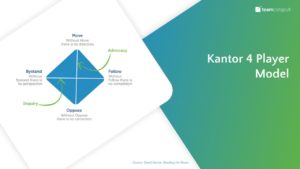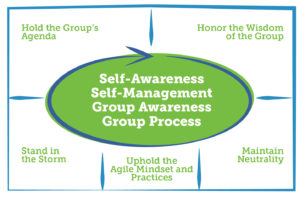Come think with me!
Here are a few questions I have for you as we start this conversation about collective intelligence.
- Do you know how to have a conversation?
- Have you ever experienced a time when you thought you were showing up to a conversation, but instead you got yelled at?
- You showed up to a conversation and instead everyone was multitasking on their phones, or on another device?
- Have you ever showed up to a conversation and instead one person really spoke the entire time and you didn’t really have a voice in the conversation at all?
George Bernard Shaw said it best:
“The single biggest problem in communication is the illusion that it has taken place.”
Often we think we are communicating when we are really doing something else entirely!
What Kinds of Conversations Do You Have?
Let’s look at metaphorically how the conversations can be broken down.
[This comes from work done by William Isaacs.]
1) Monologue
Single voice.Turn taking. Download.
2) Debate
Beating down. Advocacy. There is a winner and a loser. I am holding strongly to a point of view and my job is to persuade, convince, cajole: to bring you over to my point of view.
3) Discussion
It means to break apart. It feels a bit like table tennis. You take a topic and pull it apart in different ways and then it gets lobbed back and forth a bit.
4) Skillful Conversation
It’s the first time where inquiry comes into the conversation. It’s a bit like plowing a field. We stick long enough with a topic to understand what’s there, we are inquiring and asking questions of others.
5) Dialogue
It’s metaphorically like a pool of water. We’re contributing to a pool of meaning. And everybody has equal voice. There aren’t any particular sides. There is no known objective. The idea and new thinking emerges from conversation, rather than somebody bringing ‘the idea’ into the conversation.
The Art & Science of Conversations
I believe that conversations are the single greatest predictor of success.
Whether we are or aren’t having them and if we can learn to be more intentional about how we invite conversation, how we participate, cultivate and facilitate dialogue, I don’t believe there is anything, any challenge, any initiative that an organization is taking on that they can not skillfully navigate towards an effective outcome!
Active engagement in skillful conversation and dialogue is the key to collective intelligence and culture change!
“The fastest way to change the culture in an organization is by changing the way we talk and think together.”
Mindset Work is Needed To Engage in Meaningful Dialogue
It might take an organisation 1-2 years to put these concepts in play, and practice, in order to realize their full potential!
It all starts by learning the nuts and bolts of the structure of conversations. You need to fully understand what dialogue is and how to start thinking about it differently!
Dialogue Is How We Access Collective Intelligence
Without dialogue, we can’t change culture, we can’t get to agility, we can’t seek the big things in organizations, these solutions, or vexing issues!
Things like higher performance, agility in business, change culture, innovation, looking to anticipate what’s coming in terms of change.
The solutions to these issues emerge from dialogue. Not from tools, processes or frameworks.
Solutions emerge from that collective pool of meaning!
Interested in learning more?
Watch and Listen!
This article is based on my presentation for the Business Agility Conference in June 2021.
It was recorded and can be watched right here!
Dialogue is the Foundation to Increasing Agility
It’s not about what happens, it is about how you chose to respond to it! Learn more about dialogue!
Leadership is a journey and your collaborative leadership journey can begin right here.
yoyo

